Jan 21, 2011 © Ulrich Theobald
Sancai tuhui 三才圖會 "Collected illustrations of the Three Realms", also called Sancai tushuo 三才圖說, is a richly illustrated encyclopaedia compiled during the Ming period 明 (1368-1644) by Wang Qi 王圻 (jinshi degree 1565) and his son Wang Siyi 王思義. Wang Qi is also known for his statecraft encyclopaedia Xu wenxian tongkao 續文獻通考.
The title "Three Realms" refers to Heaven, Earth, and Man. The book was finished and printed in 1607. It is divided into 106 juan, and the themes are arranged in 14 fields covering themes from Heaven and astronomy to geography, personalities, agricultural activities through the year, palaces, tools and implements, the human body, clothing, human affairs, rites and etiquette, jewels, writing, and finally animals and plants. The core part of the book is the countless reliable and scientific illustrations(barring creatures of mythology), each accompanied by an explanatory text. The objective of Wang Qi was to bring together the illustrations dispersed in many different books, which are often hidden between many text pages and thus not easy to find. The illustrations are presented first and then described with a short text. Although the collection Sancai tuhui presents a vast amount of knowledge from different fields, the weakness lies just in its overemphasising the illustrations and neglecting the text.
Figures 1-7. Illustrations with text from the Sancai tuhui 三才圖會
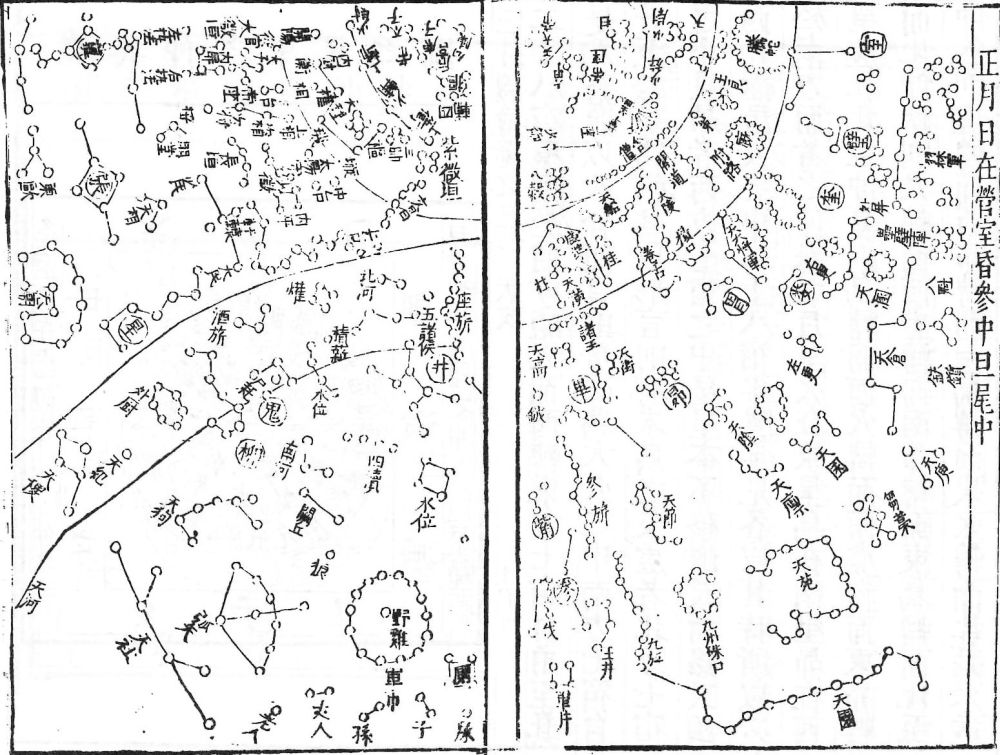 |
Chart of the starry sky during the first lunar month, with the Milky Way. |
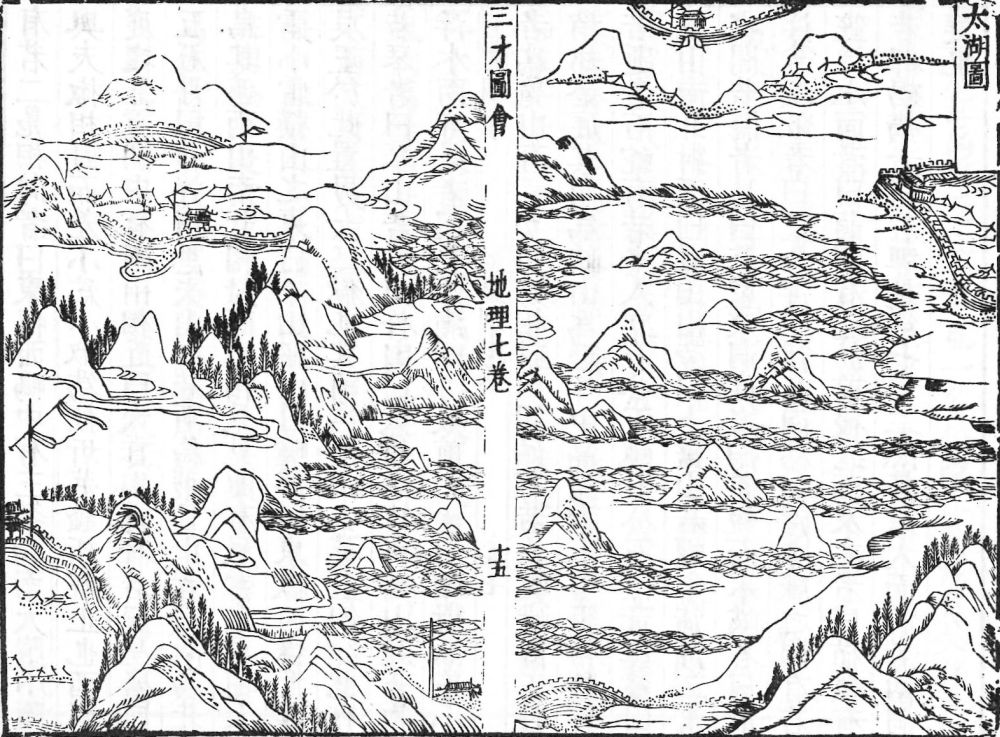 |
The landscape of Lake Taihu 太湖, Jiangsu. |
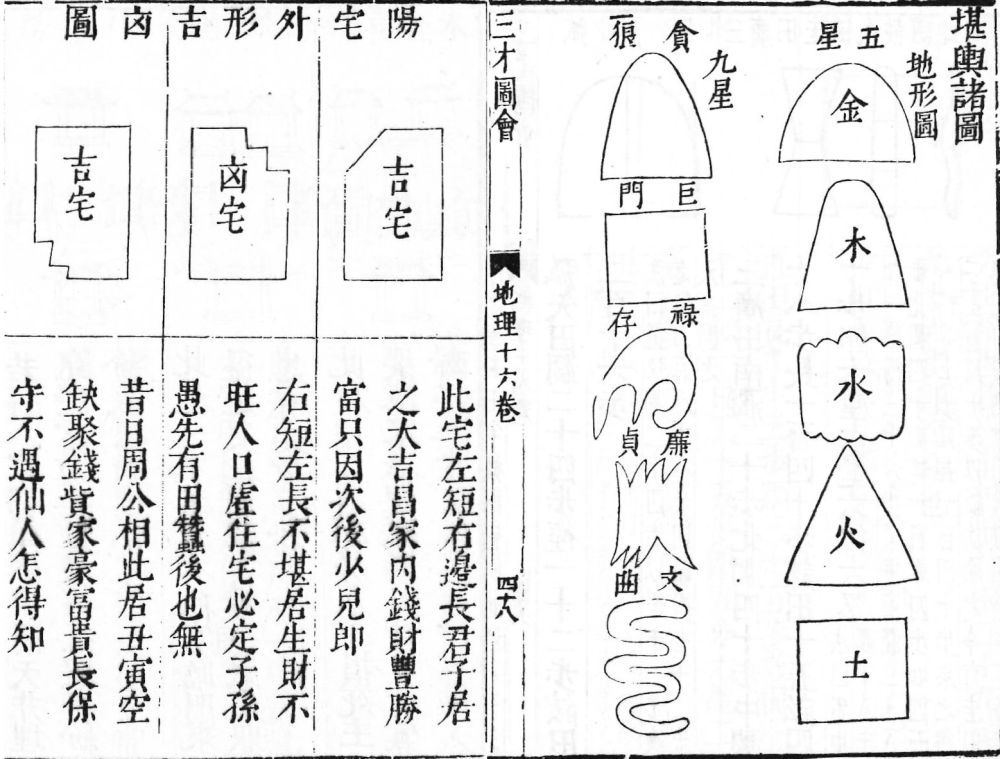 |
Collage of two pages showing geomantic imaginative mountains and auspicious and inauspicious forms of houses. |
 |
Image and text describing the people of the Jurchens (Nüzhen 女真), the later Manchus. |
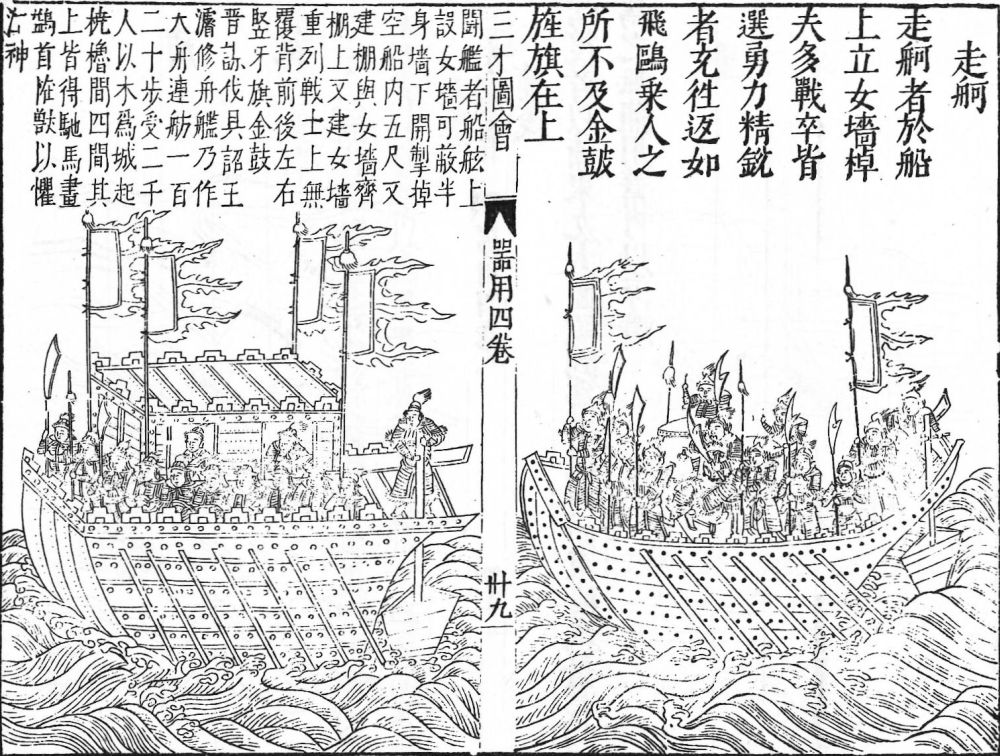 |
Iron-clad war ships. |
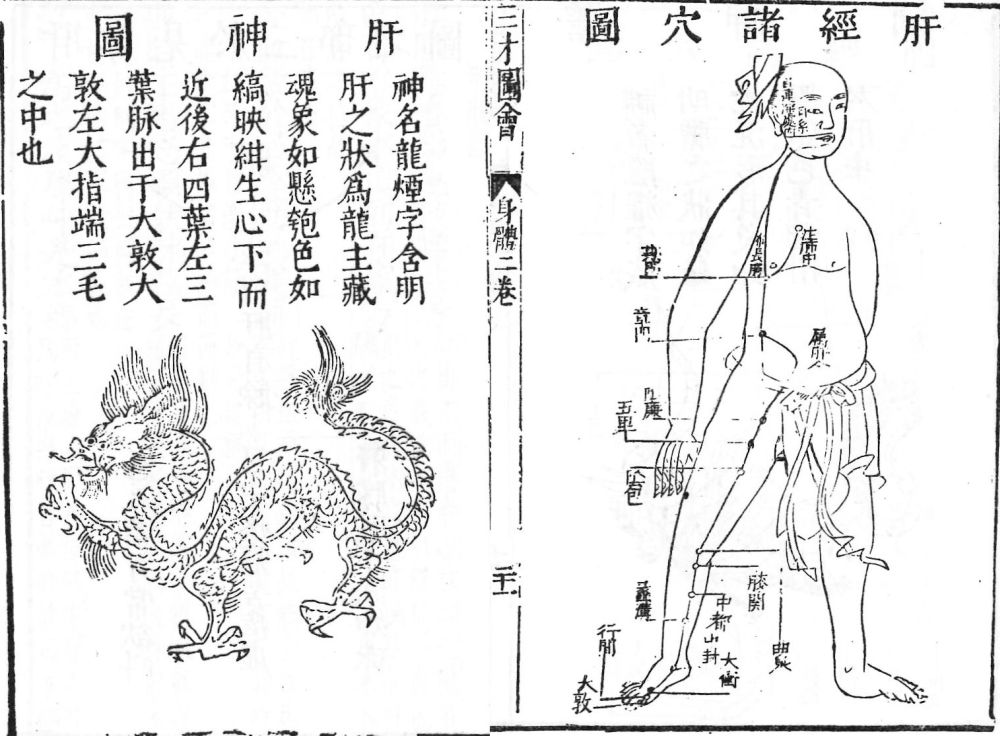 |
Collage of an image showing the acupoints related to the liver (gan jing zhu xue 肝經諸穴), and the spirit of the liver (ganshen 肝神), pictured as a kind of dragon. |
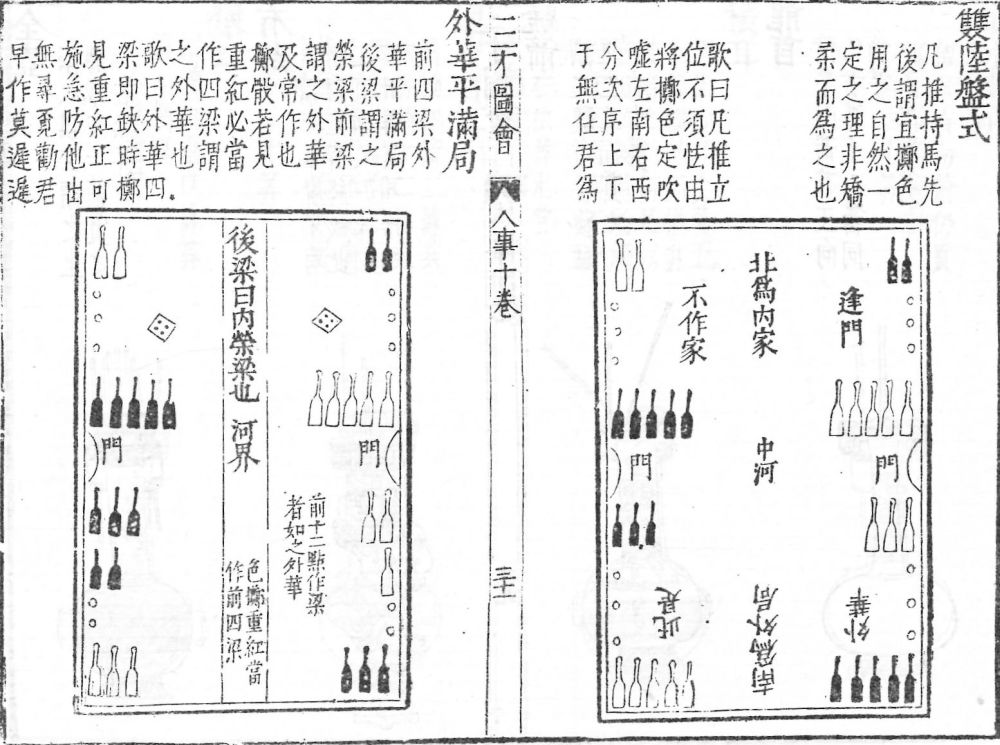 |
Images of different kinds of board games (shuanglu 雙陸). |
The earliest surviving prints date from the Wanli 萬曆 (1573-1619) and the Qianlong 乾隆 (1736-1795) reign-periods. The Chinese Academy of Sciences (Zhongguo Kexue Yuan 中國科學院) owns a printed edition from the late 19th century. In 1970, the Chengwen Press 成文書社 in Taibei published it as a six-volume edition; in 1987, the Guangling Guji Press 廣陵古籍刻印社 published a downscaled reprint; and in 1988, the Shanghai Guji Press 上海古籍出版社 published another facsimile edition.
Table 1. Contents of the Sancai tuhui 三才圖會
| I |
天文 |
Astronomy 1-4 |
| II |
地理 |
Administrative geography 1-16 |
| III |
人物 |
Personalities 1-14 |
| IV |
時令 |
Commands concerning the seasons 1-4 |
| V |
宮室 |
Palaces and houses 1-4 |
| VI |
器用 |
Tools 1-12 |
| VII |
身體 |
The body 1-7 |
| VIII |
衣服 |
Clothes 1-3 |
| IX |
人事 |
Human affairs 1-10 |
| X |
儀制 |
Ritual system 1-8 |
| XI |
珍寶 |
Precious objects 1-2 |
| XII |
文史 |
Cultural objects 1-4 |
| XIII |
鳥獸 |
Fauna 1-6 |
| XIV |
草木 |
Flora 1-12 |
Sources:
He Limin 何立民. 2014. "Wang Qi fuzi Sancai tihui de tedian yu jiazhi 王圻父子《三才圖會》的特點與價值." Shilin 史林 2014 (3): 54-59+190.
Li Baojiang 李保江. 2021. "Sancai tuhui zhong yueqi, wuqi lei yinyuexue yanjiu 《三才圖會》中“樂器、舞器類”音樂學研究." Shandong yishu 山東藝術 2021 (4): 88-96.
Li Bingzhong 李秉忠, Wei Canjin 衛燦金, and Lin Conglong 林從龍, eds. 1990. Jianming wenshi zhishi cidian 簡明文史知識詞典, 576. Xi'an: Shaanxi renmin chubanshe.
Li Chenghua 李承華. 2012. "Sancai tuhui tuwen xushi ji shijue jiegou 《三才圖會》“圖文”叙事及視覺結構." Xin meishu 新美術 2012 (6): 36-42.
Li Qiufang 李秋芳. 2009. "Sancai tuhui ji wi keji shi jiazhi 《三才圖會》及其科技史價值." Huainan Shifan Xueyuan xuebao 淮南師範學院學報 2009 (1): 5-7.
Li Xueqin 李學勤, and Lü Wenyu 呂文郁, eds. 1996. Siku da cidian 四庫大辭典, vol. 2, 2052. Changchun: Jilin daxue chubanshe.
Liu Yaping 劉亞萍. 2023. "Zhuanyi yu fuxian: Lun Sancai tuhui tuwen jiegou zhi yu taoci yanjiu de yiyi 轉譯與復現——論“三才圖會”“圖文”街頭之于陶瓷研究的意義." Taoci yishu 陶瓷藝術 2023 (4): 94-96+153.
Lu Yilu 鹿憶鹿. 2020. "Ren-shen gong chu, chang-yi bu fen: Sancai tuhui dui Shanhaijing de tuwen yinyong 人神共處,常異不分——《三才圖會》對《山海經》的圖文引用." Minjian wenhua luntan 民間文化論壇 2020 (4): 69-79.
Pan Yinsheng 潘寅生, and Guo Jiankui 郭建魁, eds. 1993. Zhonghua shehui kexue gongjushu cidian 中華社會科學工具書辭典, 689. Lanzhou: Gansu renmin chubanshe.
Ren Huanlin 任唤麟, Gong Shengsheng 龔勝生, and Zhou Jun 周軍. 2011. "Wan-Ming lüyou ziyuan leixing jiegou yu diyu fenbu: Yi Sancai tuhui Dili yu Mingshan shengji wei shuju laiyuan 晚明旅遊資源類型結構與地域分佈——以《三才圖會·地理》與 《名山勝記》為數據來源." Dili yanjiu 地理研究 30 (3): 477-485.
Shen Yun 沈歆. 2020. "Sancai tuhui shenti tuxiang zhong de wan-Mign ren shenti zhishi yu guannian 《三才圖會》身體圖像中的晚明人身體知識與觀念." Zhongguo shuhua 中國書畫 2020 (1): 26-29.
Wang Xingya 王興亞. 1992. "Sancai tuhui 三才圖會." In Zhongguo da baike quanshu 中國大百科全書, part Zhongguo lishi 中國歷史, vol. 2, 866. Beijing and Shanghai: Zhongguo da baike quanshu chubanshe.
Wang Yuguang 王余光, Xu Yan 徐雁, ed. 1990. Zhongguo dushu da cidian 中國讀書大辭典, 1092. Nanjing: Nanjing daxue chubanshe.
Wu Feng 吳楓, ed. 1987. Jianming Zhongguo guji cidian 簡明中國古籍辭典, 20. Changchun: Jilin wenshi chubanshe.
Yu Hui 喻輝. 1996. "Sancai tuhui 三才圖會." In Zhongguo xueshu mingzhu tiyao 中國學術名著提要, vol. Yishu 藝術卷, edited by Zhou Gucheng 周谷城, 120. Shanghai: Fudan daxue chubanshe.
Yu Xinwen 俞昕雯. 2021. "Sancai tuhui Dili lei tupu yuliu kao 《三才圖會·地理類》圖譜源流考." Zhongguo dianji yu wenhua 中國典籍與文化 116 (1): 41-52+161.
Yu Zhao 于釗, and Lin Xun 林迅. 2018. "Zhongguo gudai sheji sixiang dui shehui sheji de jiazhi yanjiu: Yi Sancai tuhui wei li 中國古代設計思想對社會設計的價值研究——以《三才圖會》為例." Chuangyi yu sheji 創意與設計 55 (2): 41-45.
Zhao Hankun 趙含坤, ed. 2005. Zhongguo leishu 中國類書, 261-262. Shijiazhuang: Hebei renmin chubanshe.
Zhao Ting 趙婷. 2022. "Sancai tuhui jilu zhong yunhan de zaowu faze 《三才圖會》輯錄中蘊含的造物法則." Mei yu shidai 美與時代 2022 (12): 35-38.
Zou Qichang 鄒其昌, and Fan Xionghua 范雄華. 2018. "Lun Sancai tuhui sheji lilun tixi de dangdai jiangou: Zhonghua kaogongxue shieji lilun tixi yanjiu xili 論《三才圖會》設計理論體系的當代建構——中華考工學設計理論體系研究系列." Chuangyi yu sheji 創意與設計 59 (6): 5-17.






